Kinesiology Taping Does Not Affect Tarsal Joint Motion During Selected Exercises in Dogs †
Simple Summary
Abstract
1. Introduction
2. Materials and Methods
3. Results
3.1. Participants
3.2. Kinesiology Tape Longevity
3.3. Kinematic Gait Evaluation
3.4. Kinetic Gait Evaluation
4. Discussion
5. Conclusions
Author Contributions
Funding
Institutional Review Board Statement
Informed Consent Statement
Data Availability Statement
Acknowledgments
Conflicts of Interest
References
- Banerjee, G.; Briggs, M.; Johnson, M.I. The Immediate Effects of Kinesiology Taping on Cutaneous Blood Flow in Healthy Humans under Resting Conditions: A Randomised Controlled Repeated-Measures Laboratory Study. PLoS ONE 2020, 15, e0229386. [Google Scholar] [CrossRef] [PubMed]
- Chan, M.C.E.; Wee, J.W.J.; Lim, M.H. Does Kinesiology Taping Improve the Early Postoperative Outcomes in Anterior Cruciate Ligament Reconstruction? A Randomized Controlled Study. Clin. J. Sport Med. 2017, 27, 260–265. [Google Scholar] [CrossRef]
- Kaltron, A.; Bar-Sela, S. A Systematic Review of the Effectiveness of Kinesio Taping®—Fact or Fashion? Eur. J. Phys. Rehabil. Med. 2013, 49, 699–709. [Google Scholar]
- Lee, K.; Yi, C.; Lee, S. The Effects of Kinesiology Taping Therapy on Degenerative Knee Arthritis Patients’ Pain, Function and Joint Range of Motion. J. Phys. Ther. Sci. 2016, 28, 63–66. [Google Scholar] [CrossRef]
- Mao, H.Y.; Hu, M.T.; Yen, Y.Y.; Lan, S.J.; Lee, S. Da Kinesio Taping Relieves Pain and Improves Isokinetic Not Isometric Muscle Strength in Patients with Knee Osteoarthritis—A Systematic Review and Meta-Analysis. Int. J. Environ. Res. Public Health 2021, 18, 10440. [Google Scholar] [CrossRef] [PubMed]
- Lim, E.C.W.; Tay, M.G.X. Kinesio Taping in Musculoskeletal Pain and Disability That Lasts for More than 4 Weeks: Is It Time to Peel off the Tape and Throw It out with the Sweat? A Systematic Review with Meta-Analysis Focused on Pain and Also Methods of Tape Application. Br. J. Sports Med. 2015, 49, 1558–1566. [Google Scholar] [CrossRef]
- Montalvo, A.M.; Cara, E.L.; Myer, G.D. Effect of Kinesiology Taping on Pain in Individuals with Musculoskeletal Injuries: Systematic Review and Meta-Analysis. Physician Sportsmed. 2014, 42, 48–57. [Google Scholar] [CrossRef]
- Parreira, P.d.C.S.; Costa, L.d.C.M.; Junior, L.C.H.; Lopes, A.D.; Costa, L.O.P. Current Evidence Does Not Support the Use of Kinesio Taping in Clinical Practice: A Systematic Review. J. Physiother. 2014, 60, 31–39. [Google Scholar] [CrossRef]
- Ericson, C.; Stenfeldt, P.; Hardeman, A.; Jacobson, I. The Effect of Kinesiotape on Flexion-extension of the Thoracolumbar Back in Horses at Trot. Animals 2020, 10, 301. [Google Scholar] [CrossRef]
- Drouin, J.L.; Mcalpine, C.T.; Primak, K.A.; Kin, B.A.; Kissel, J.; Drouin, J. The Effects of Kinesiotape on Athletic-Based Performance Outcomes in Healthy, Active Individuals: A Literature Synthesis Private Practice. J. Can. Chiropr. Assoc. 2013, 57, 356–365. [Google Scholar]
- Csapo, R.; Alegre, L.M. Effects of Kinesio® Taping on Skeletal Muscle Strength-A Meta-Analysis of Current Evidence. J. Sci. Med. Sport 2015, 18, 450–456. [Google Scholar] [CrossRef] [PubMed]
- de Freitas, F.S.; Brown, L.E.; Gomes, W.A.; Behm, D.G.; Marchetti, P.H. No Effect of Kinesiology Tape on Passive Tension, Strength or Quadriceps Muscle Activation or during Maximal Voluntary Isometric Contraction in Resistance Trained Men. Int. J. Sports Phys. Ther. 2018, 13, 661–667. [Google Scholar] [CrossRef]
- Farquharson, C.; Greig, M. Kinesiology Tape Mediates Soccer-Simulated and Local Peroneal Fatigue in Soccer Players. Res. Sports Med. 2017, 25, 313–321. [Google Scholar] [CrossRef]
- Konishi, Y. Tactile Stimulation with Kinesiology Tape Alleviates Muscle Weakness Attributable to Attenuation of Ia Afferents. J. Sci. Med. Sport 2013, 16, 45–48. [Google Scholar] [CrossRef]
- Lau, K.K.L.; Cheng, K.C.C. Effectiveness of Taping on Functional Performance in Elite Athletes: A Systematic Review. J. Biomech. 2019, 90, 16–23. [Google Scholar] [CrossRef]
- Fong, S.S.M.; Tam, Y.T.; Macfarlane, D.J.; Ng, S.S.M.; Bae, Y.H.; Chan, E.W.Y.; Guo, X. Core Muscle Activity during TRX Suspension Exercises with and without Kinesiology Taping in Adults with Chronic Low Back Pain: Implications for Rehabilitation. Evid.-Based Complement. Altern. Med. 2015, 2015, 910168. [Google Scholar] [CrossRef] [PubMed]
- Poon, K.Y.; Li, S.M.; Roper, M.G.; Wong, M.K.M.; Wong, O.; Cheung, R.T.H. Kinesiology Tape Does Not Facilitate Muscle Performance: A Deceptive Controlled Trial. Man. Ther. 2015, 20, 130–133. [Google Scholar] [CrossRef] [PubMed]
- Nunes, G.S.; Vargas, V.Z.; Wageck, B.; dos Santos Hauphental, D.P.; da Luz, C.M.; de Noronha, M. Kinesio Taping Does Not Decrease Swelling in Acute, Lateral Ankle Sprain of Athletes: A Randomised Trial. J. Physiother. 2015, 61, 28–33. [Google Scholar] [CrossRef]
- Gabriel, E.H.; Sibert, N.C.; Powden, C.J. Kinesiology Therapeutic Taping Does Not Reduce Swelling Caused by an Acute Ankle Sprain: A Critically Appraised Topic. J. Sport Rehabil. 2022, 31, 630–634. [Google Scholar] [CrossRef]
- Alexander, J.; Hobbs, S.J.; May, K.; Northrop, A.; Brigden, C.; Selfe, J. Postural Characteristics of Female Dressage Riders Using 3D Motion Analysis and the Effects of an Athletic Taping Technique: A Randomised Control Trial. Phys. Ther. Sport 2015, 16, 154–161. [Google Scholar] [CrossRef]
- Molle, S. Kinesio Taping Fundalmentals for the Equine Athlete. Vet. Clin. Equine 2016, 32, 103–113. [Google Scholar] [CrossRef] [PubMed]
- Ramón, T.; Prades, M.; Armengou, L.; Lanovaz, J.L.; Mullineaux, D.R.; Clayton, H.M. Effects of Athletic Taping of the Fetlock on Distal Limb Mechanics. Equine Vet. J. 2004, 36, 764–768. [Google Scholar] [CrossRef]
- Zellner, A.; Bockstahler, B.; Peham, C. The Effects of Kinesio Taping on the Trajectory of the Forelimb and the Muscle Activity of the Musculus Brachiocephalicus and the Musculus Extensor Carpi Radialis in Horses. PLoS ONE 2017, 12, e0186371. [Google Scholar] [CrossRef] [PubMed]
- Biau, S.; Burgaud, I. Application of Kinesiology Taping to Equine Abdominal Musculature in a Tension Frame for Muscle Facilitation Increases Longitudinal Activity at the Trot. Equine Vet. J. 2022, 54, 973–978. [Google Scholar] [CrossRef]
- Fu, Y.C.; Torres, B.T.; Budsberg, S.C. Evaluation of a Three-Dimensional Kinematic Model for Canine Gait Analysis. Am. J. Vet. Res. 2010, 71, 1118–1122. [Google Scholar] [CrossRef]
- Torres, B.T.; Fu, Y.C.; Sandberg, G.S.; Budsberg, S.C. Pelvic Limb Kinematics in the Dog with and without a Stifle Orthosis. Vet. Surg. 2017, 46, 642–652. [Google Scholar] [CrossRef] [PubMed]
- Sandberg, G.S.; Torres, B.T.; Budsberg, S.C. Review of Kinematic Analysis in Dogs. Vet. Surg. 2020, 49, 1088–1098. [Google Scholar] [CrossRef]
- Torres, B.T.; Gilbert, P.J.; Reynolds, L.R.; Fu, Y.C.; Navik, J.A.; Sornborger, A.; Budsberg, S.C. The Effect of Examiner Variability on Multiple Canine Stifle Kinematic Gait Collections in a 3-Dimensional Model. Vet. Surg. 2015, 44, 581–587. [Google Scholar] [CrossRef]
- Torres, B.T.; Punke, J.P.; Fu, Y.C.; Navik, J.A.; Speas, A.L.; Sornborger, A.; Budsberg, S.C. Comparison of Canine Stifle Kinematic Data Collected with Three Different Targeting Models. Vet. Surg. 2010, 39, 504–512. [Google Scholar] [CrossRef]
- Alam, S.; Malhotra, D.; Munjal, J.; Chachra, A. Immediate Effect of Kinesio Taping on Shoulder Muscle Strength and Range of Motion in Healthy Individuals: A Randomised Trial. Hong Kong Physiother. J. 2015, 33, 80–88. [Google Scholar] [CrossRef]
- Angelopoulos, P.; Mylonas, K.; Tsepis, E.; Billis, E.; Vaitsis, N.; Fousekis, K. The Effects of Instrument-Assisted Soft Tissue Mobilization, Tissue Flossing, and Kinesiology Taping on Shoulder Functional Capacities in Amateur Athletes. J. Sport Rehabil. 2021, 30, 1028–1037. [Google Scholar] [CrossRef] [PubMed]
- Altaş, E.U.; Günay Uçurum, S.; Ozer Kaya, D. Acute Effect of Kinesiology Taping on Muscle Strength, Tissue Temperature, Balance, and Mobility in Female Patients with Osteoarthritis of the Knee. Somatosens. Mot. Res. 2021, 38, 48–53. [Google Scholar] [CrossRef]
- Cavaleri, R.; Thapa, T.; Beckenkamp, P.R.; Chipchase, L.S. The Influence of Kinesiology Tape Colour on Performance and Corticomotor Activity in Healthy Adults: A Randomised Crossover Controlled Trial. BMC Sports Sci. Med. Rehabil. 2018, 10, 17. [Google Scholar] [CrossRef] [PubMed]
- Cai, C.; Au, I.P.H.; An, W.; Cheung, R.T.H. Facilitatory and Inhibitory Effects of Kinesio Tape: Fact or Fad? J. Sci. Med. Sport. 2016, 19, 109–112. [Google Scholar] [CrossRef] [PubMed]
- Halski, T.; Dymarek, R.; Ptaszkowski, K.; Słupska, L.; Rajfur, K.; Rajfur, J.; Pasternok, M.; Smykla, A.; Taradaj, J. Kinesiology Taping Does Not Modify Electromyographic Activity or Muscle Flexibility of Quadriceps Femoris Muscle: A Randomized, Placebo-Controlled Pilot Study in Healthy Volleyball Players. Med. Sci. Monit. 2015, 21, 2232–2239. [Google Scholar] [CrossRef]
- Hosp, S.; Folie, R.; Csapo, R.; Hasler, M.; Nachbauer, W. Eccentric Exercise, Kinesiology Tape, and Balance in Healthy Men. J. Athl. Train. 2017, 52, 636–642. [Google Scholar] [CrossRef]
- Hosp, S.; Csapo, R.; Heinrich, D.; Hasler, M.; Nachbauer, W. Does Kinesiology Tape Counter Exercise-Related Impairments of Balance in the Elderly? Gait Posture 2018, 62, 167–172. [Google Scholar] [CrossRef]
- Hosp, S.; Bottoni, G.; Heinrich, D.; Kofler, P.; Hasler, M.; Nachbauer, W. A Pilot Study of the Effect of Kinesiology Tape on Knee Proprioception after Physical Activity in Healthy Women. J. Sci. Med. Sport. 2015, 18, 709–713. [Google Scholar] [CrossRef]
- Blein-Ibáñez, Á.; Molina-Rueda, F.; Bebea-Zamorano, F.N.; López-Román, A.; Navarro-López, V.; Alguacil-Diego, I.M. Kinesiology Tape versus Non-Standardized Tape in the Treatment of Balance in Non-Operated Anterior Cruciate Ligament Rupture Patients: A Randomized Controlled Trial. Somatosens. Mot. Res. 2023, 41, 222–229. [Google Scholar] [CrossRef]
- Rogers, M.E.; Jimoh, J.M.; Zhang, Q.; Patterson, J.A.; Bomgardner, R.; Rogers, N.L. Effects of Kinesiology Tape on Balance; Proc of American College of Sports Medicine: Boston, MA, USA, 2016; p. 142. [Google Scholar]
- Bailey, D.; Firth, P. Does Kinesiology Taping of the Ankles Affect Proprioceptive Control in Professional Football (Soccer) Players? Phys. Ther. Sport 2017, 25, 94–98. [Google Scholar] [CrossRef]
- Park, J.S.; Yoon, T.; Lee, S.H.; Hwang, N.K.; Lee, J.H.; Jung, Y.J.; Lee, G. Immediate Effects of Kinesiology Tape on the Pain and Gait Function in Older Adults with Knee Osteoarthritis. Medicine 2019, 98, e17880. [Google Scholar] [CrossRef] [PubMed]
- Lopes, M.; Torres, R.; Romão, D.; Dias, M.; Valério, S.; Espejo-Antúnez, L.; Costa, R.; Ribeiro, F. Kinesiology Tape Increases Muscle Tone, Stiffness, and Elasticity: Effects of the Direction of Tape Application. J. Bodyw. Mov. Ther. 2022, 30, 176–180. [Google Scholar] [CrossRef] [PubMed]
- Magalhães, I.; Bottaro, M.; Mezzarane, R.A.; Neto, F.R.; Rodrigues, B.A.; Ferreira-Júnior, J.B.; Carregaro, R.L. Kinesiotaping Enhances the Rate of Force Development but Not the Neuromuscular Efficiency of Physically Active Young Men. J. Electromyogr. Kinesiol. 2016, 28, 123–129. [Google Scholar] [CrossRef] [PubMed]
- Naugle, K.E.; Hackett, J.; Aqeel, D.; Naugle, K.M. Effect of Different Kinesio Tape Tensions on Experimentally-Induced Thermal and Muscle Pain in Healthy Adults. PLoS ONE 2021, 16, e0259433. [Google Scholar] [CrossRef]
- Choi, I.R.; Lee, J.H. Effect of Kinesiology Tape Application Direction on Quadriceps Strength. Medicine 2018, 97, e11038. [Google Scholar] [CrossRef]
- Choi, I.R.; Lee, J.H. Effects of the Direction of Kinesiology Tape Application on the Delayed Onset of Quadriceps Muscle Fatigue in Athletes. Isokinet. Exerc. Sci. 2019, 27, 235–240. [Google Scholar] [CrossRef]
- Dolphin, M.; Brooks, G.; Calancie, B.; Rufa, A. Does the Direction of Kinesiology Tape Application Influence Muscle Activation in Asymptomatic Individuals? Int. J. Sports Phys. Ther. 2021, 16, 135–144. [Google Scholar] [CrossRef]
- Matheus, J.P.C.; Zille, R.R.; Gomide Matheus, L.B.; Lemos, T.V.; Carregaro, R.L.; Shimano, A.C. Comparison of the Mechanical Properties of Therapeutic Elastic Tapes Used in Sports and Clinical Practice. Phys. Ther. Sport 2017, 24, 74–78. [Google Scholar] [CrossRef]
- Selva, F.; Pardo, A.; Aguado, X.; Montava, I.; Gil-Santos, L.; Barrios, C. A Study of Reproducibility of Kinesiology Tape Applications: Review, Reliability and Validity. BMC Musculoskelet. Disord. 2019, 20, 153. [Google Scholar] [CrossRef]
- Tunakova, V.; Tunak, M.; Mullerova, J.; Kolinova, M.; Bittner, V. Material, Structure, Chosen Mechanical and Comfort Properties of Kinesiology Tape. J. Text. Inst. 2017, 108, 2132–2146. [Google Scholar] [CrossRef]
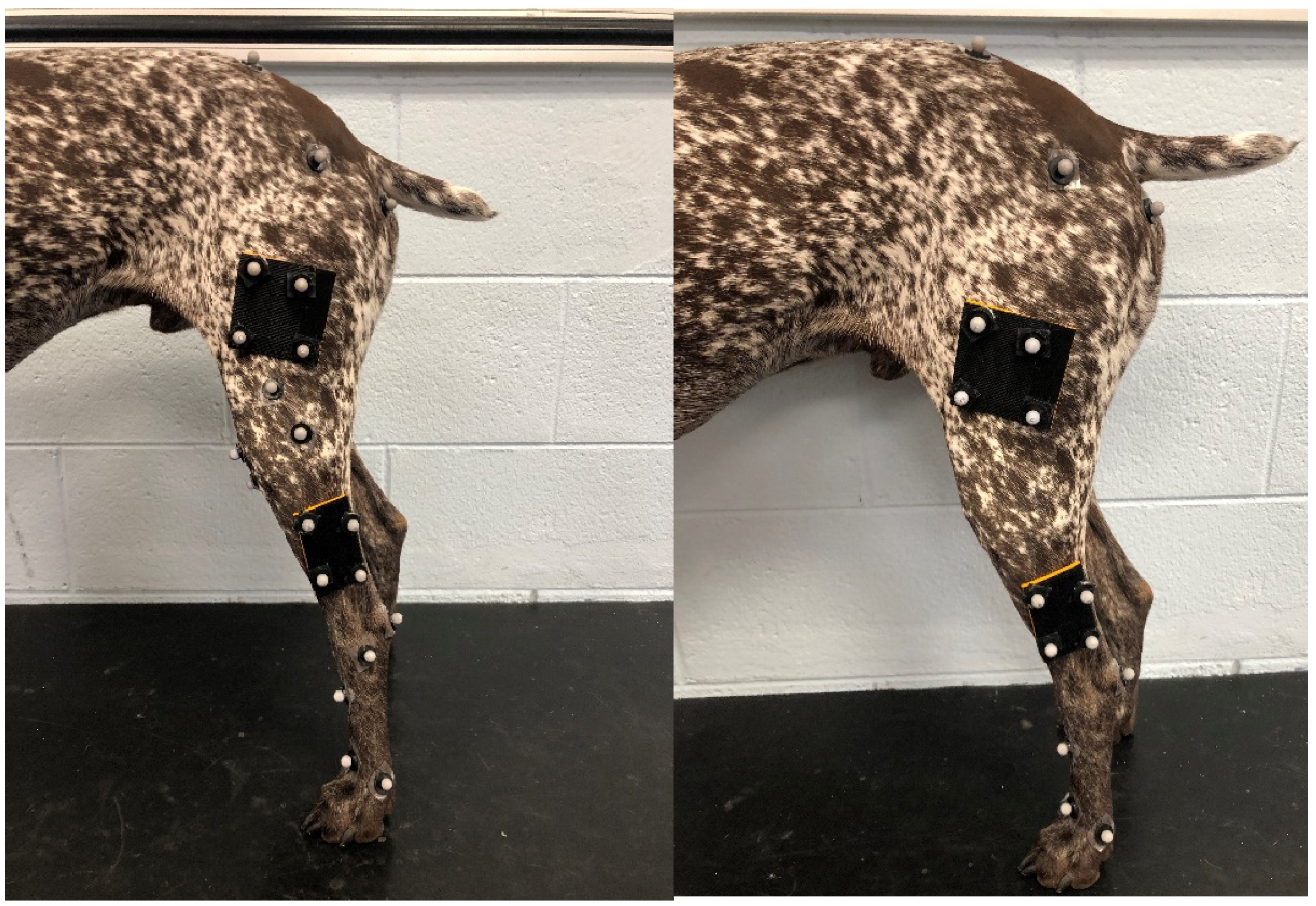
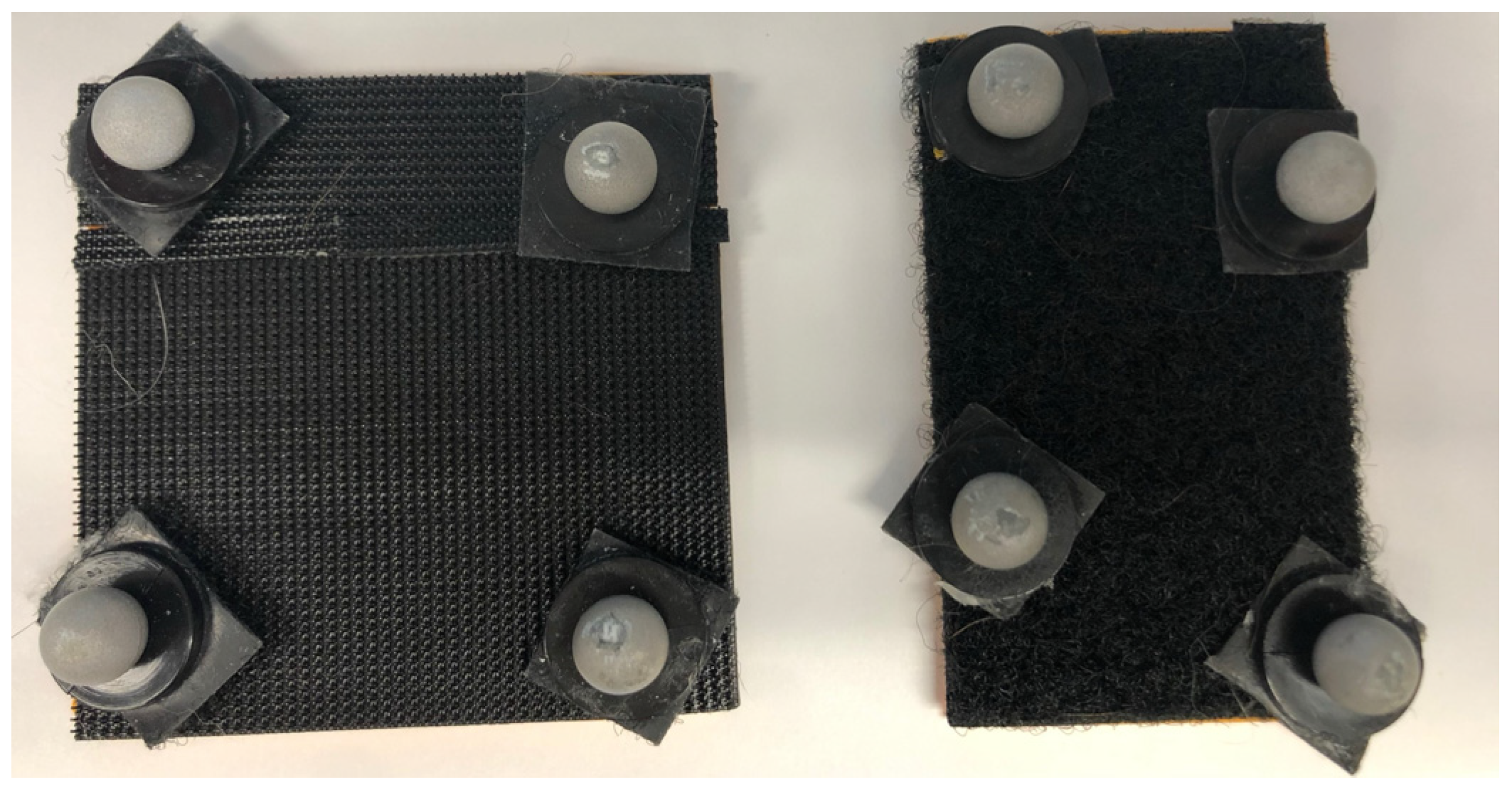

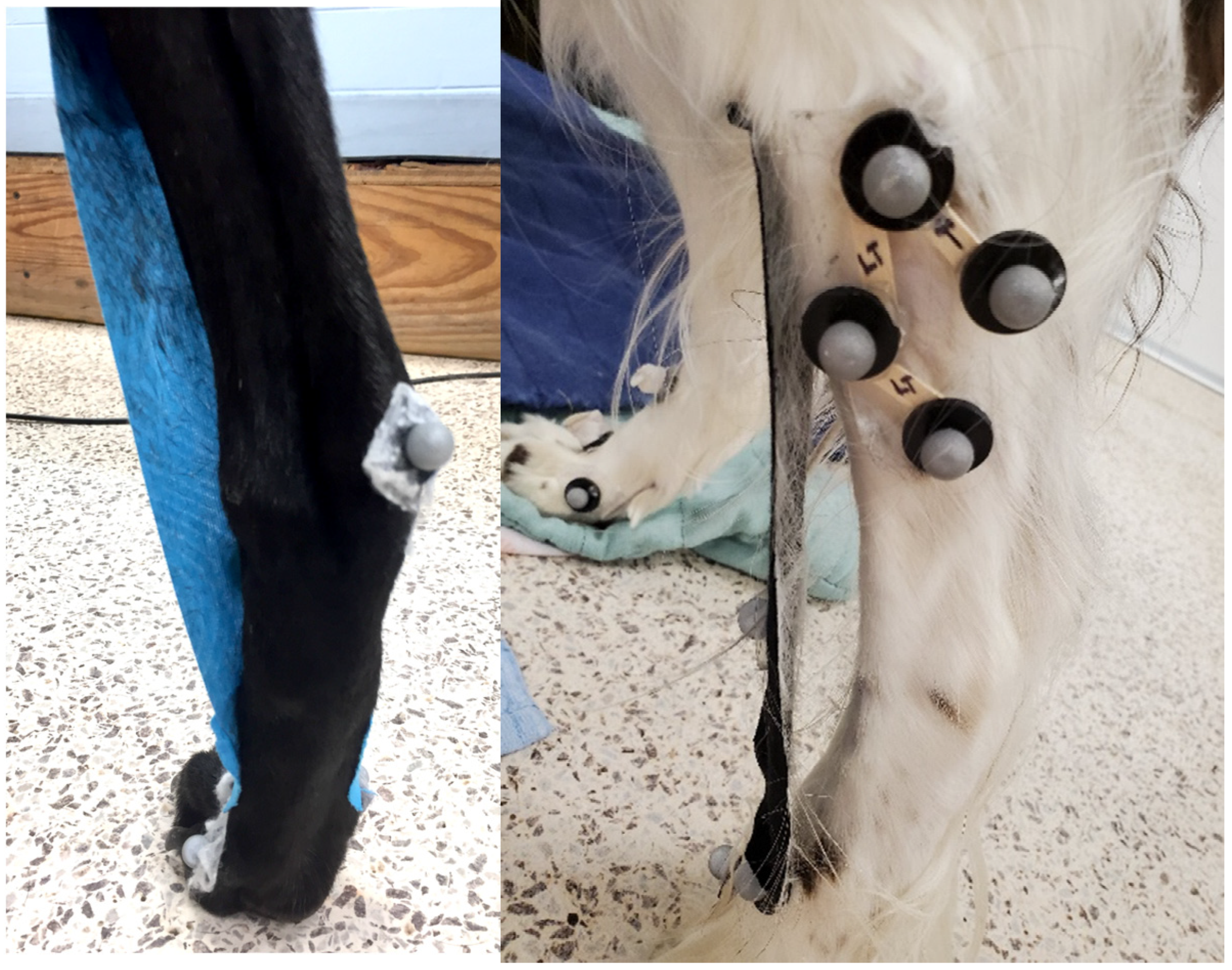
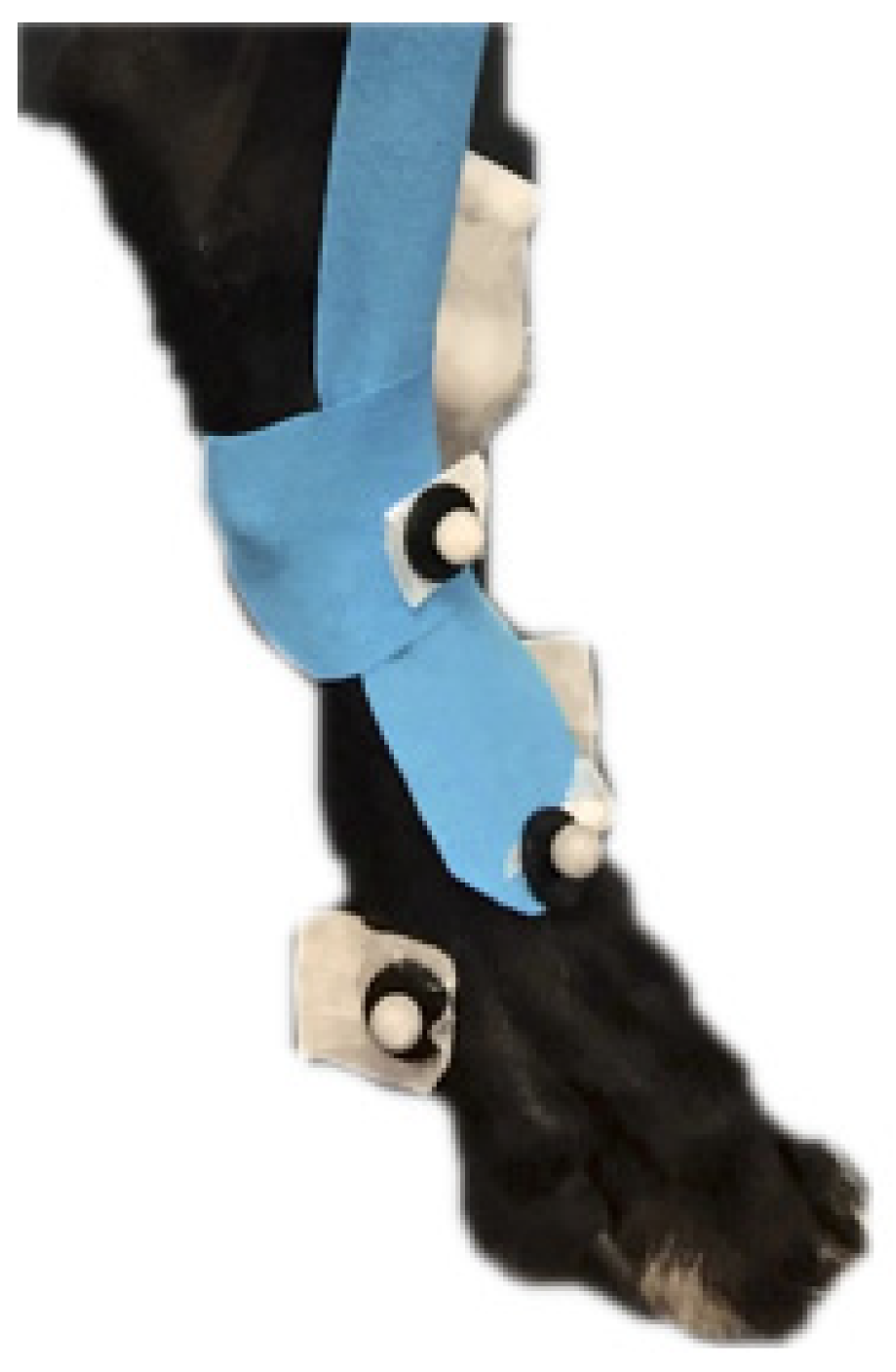

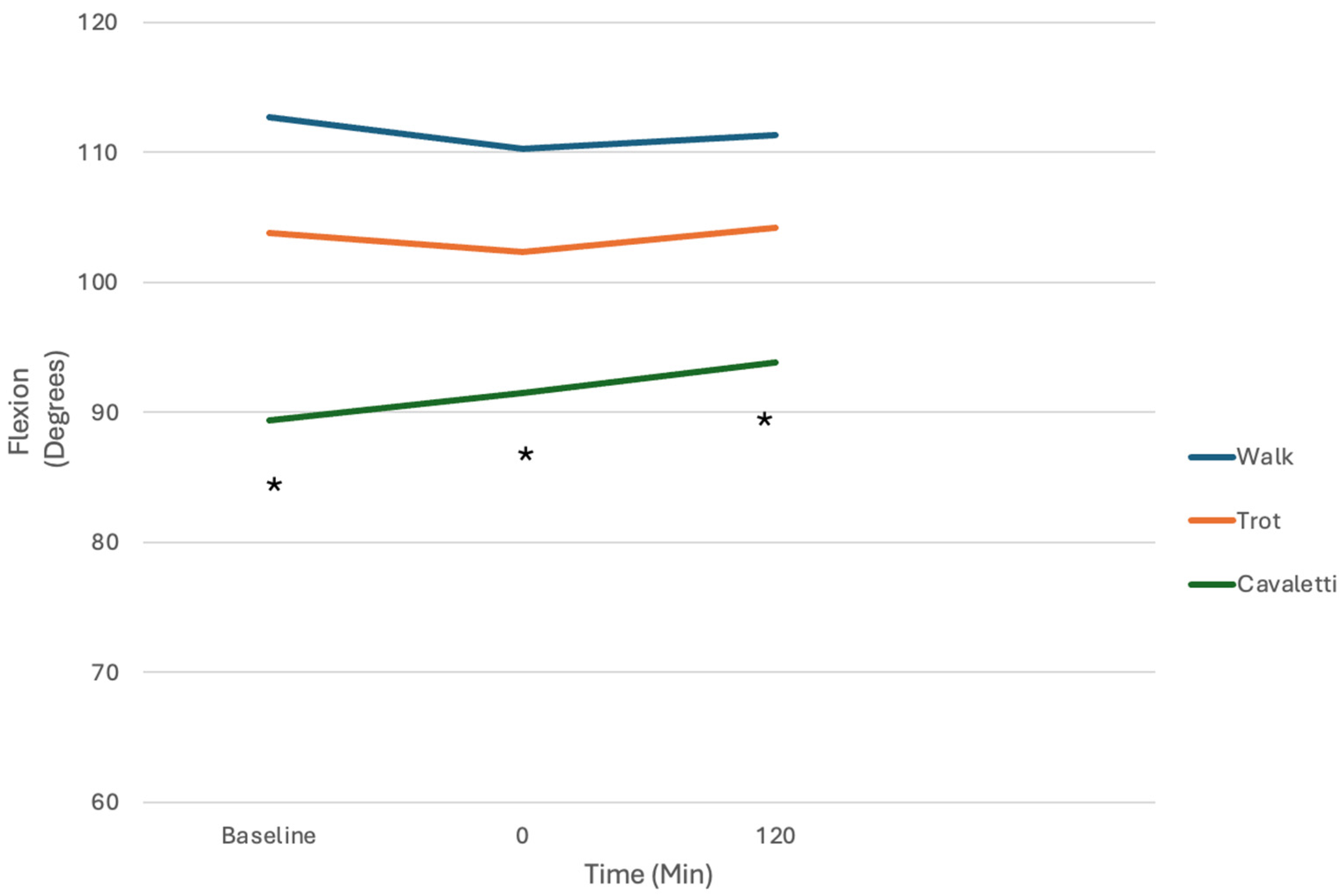
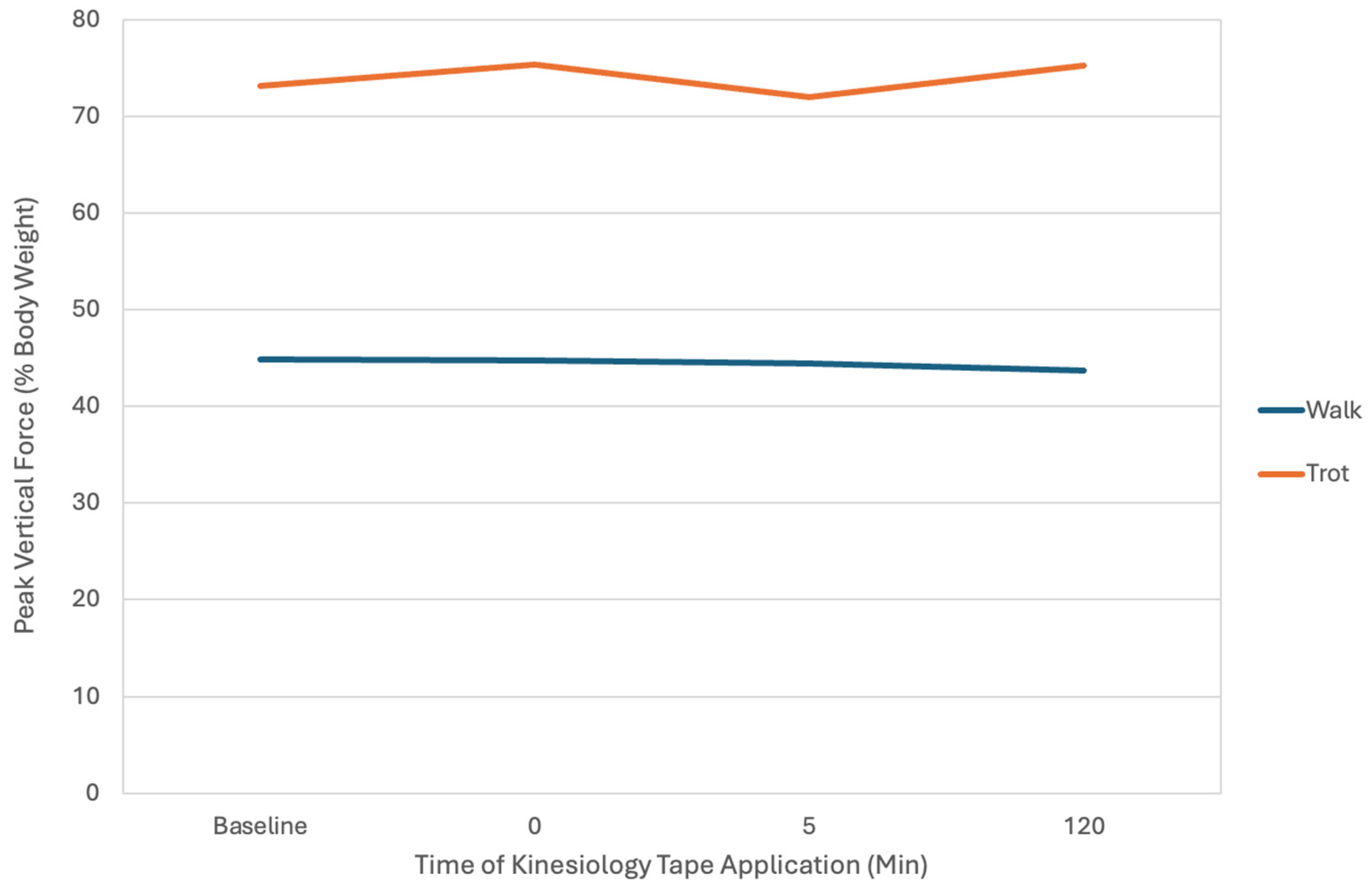
| Pelvic Limb Segments | Marker Location (Right and Left Limb) |
|---|---|
| Pelvis | Iliac wing |
| Ischium | |
| Femur | Greater trochanter |
| Lateral epicondyle ** | |
| Medial epicondyle ** | |
| Tibia | Fibular head ** |
| Proximal tibial crest ** | |
| Distal tibial crest ** | |
| Lateral malleolus ** | |
| Medial malleolus ** | |
| Foot | Point of calcaneus |
| Metatarsophalangeal joint 2 | |
| Metatarsophalangeal joint 5 | |
| Proximal tarsometatarsal joint | |
| Distal tarsometatarsal joint | |
| Cluster Markers (4 each) | Femoral cluster |
| Tibial cluster |
| Tarsus Kinematic Variables (p Values) | ||||
|---|---|---|---|---|
| Comparison | Angular Acceleration | Angular Velocity | Maximum Flexion | Minimum Flexion |
| Affected vs. Unaffected Leg | 0.5042 | 0.5418 | 0.6946 | 0.7511 |
| Exercises | 0.0004 | 0.0001 | 0.1554 | <0.0001 |
| Leg vs. Exercises | 0.7955 | 0.4757 | 0.3118 | 0.4251 |
| Time | 0.7509 | 0.9452 | 0.9960 | 0.3644 |
| Leg vs. Time | 0.9848 | 0.9041 | 0.5699 | 0.8166 |
| Exercises vs. Time | 0.0861 | 0.3684 | 0.3258 | 0.0596 |
| Leg vs. Exercises vs. Time | 0.2671 | 0.5127 | 0.8765 | 0.9506 |
| Stifle Kinematic Variables (p Values) | ||||
|---|---|---|---|---|
| Comparison | Angular Acceleration | Angular Velocity | Maximum Flexion | Minimum Flexion |
| Affected vs. Unaffected Leg | 0.2613 | 0.1333 | 0.6581 | 0.9445 |
| Exercises | <0.0001 | <0.0001 | 0.0885 | <0.0001 |
| Leg vs. Exercises | 0.3807 | 0.1368 | 0.7262 | 0.9023 |
| Time | 0.3194 | 0.2521 | 0.9675 | 0.3826 |
| Leg vs. Time | 0.6637 | 0.0665 | 0.0747 | 0.8477 |
| Exercises vs. Time | 0.027 | 0.5549 | 0.2693 | 0.3152 |
| Leg vs. Exercises vs. Time | 0.2032 | 0.534 | 0.1465 | 0.2343 |
| Kinetic Variables (p Values) | |||
|---|---|---|---|
| Comparison | Peak Vertical Force (ZPeak) | Propulsion (YAPeak) | Braking (YBPeak) |
| Affected vs. Unaffected Leg | 0.7838 | 0.5418 | 0.4610 |
| Exercises | <0.0001 | 0.0002 | 0.2631 |
| Leg × Exercises | 0.8394 | 0.9706 | 0.9144 |
| Time | 0.7132 | 0.2127 | 0.3422 |
| Leg vs. Time | 0.4063 | 0.3110 | 0.8742 |
| Exercises × Time | 0.0514 | 0.5281 | 0.9687 |
| Leg × Exercises × Time | 0.9915 | 0.7742 | 0.2417 |
Disclaimer/Publisher’s Note: The statements, opinions and data contained in all publications are solely those of the individual author(s) and contributor(s) and not of MDPI and/or the editor(s). MDPI and/or the editor(s) disclaim responsibility for any injury to people or property resulting from any ideas, methods, instructions or products referred to in the content. |
© 2025 by the authors. Licensee MDPI, Basel, Switzerland. This article is an open access article distributed under the terms and conditions of the Creative Commons Attribution (CC BY) license (https://creativecommons.org/licenses/by/4.0/).
Share and Cite
Noel, R.C.; Shaw, L.M.; Millis, N.H.; Janas, K.; Millis, D.L. Kinesiology Taping Does Not Affect Tarsal Joint Motion During Selected Exercises in Dogs. Vet. Sci. 2025, 12, 439. https://doi.org/10.3390/vetsci12050439
Noel RC, Shaw LM, Millis NH, Janas K, Millis DL. Kinesiology Taping Does Not Affect Tarsal Joint Motion During Selected Exercises in Dogs. Veterinary Sciences. 2025; 12(5):439. https://doi.org/10.3390/vetsci12050439
Chicago/Turabian StyleNoel, Rebecca C., Leann M. Shaw, Nicholas H. Millis, Krysta Janas, and Darryl L. Millis. 2025. "Kinesiology Taping Does Not Affect Tarsal Joint Motion During Selected Exercises in Dogs" Veterinary Sciences 12, no. 5: 439. https://doi.org/10.3390/vetsci12050439
APA StyleNoel, R. C., Shaw, L. M., Millis, N. H., Janas, K., & Millis, D. L. (2025). Kinesiology Taping Does Not Affect Tarsal Joint Motion During Selected Exercises in Dogs. Veterinary Sciences, 12(5), 439. https://doi.org/10.3390/vetsci12050439








